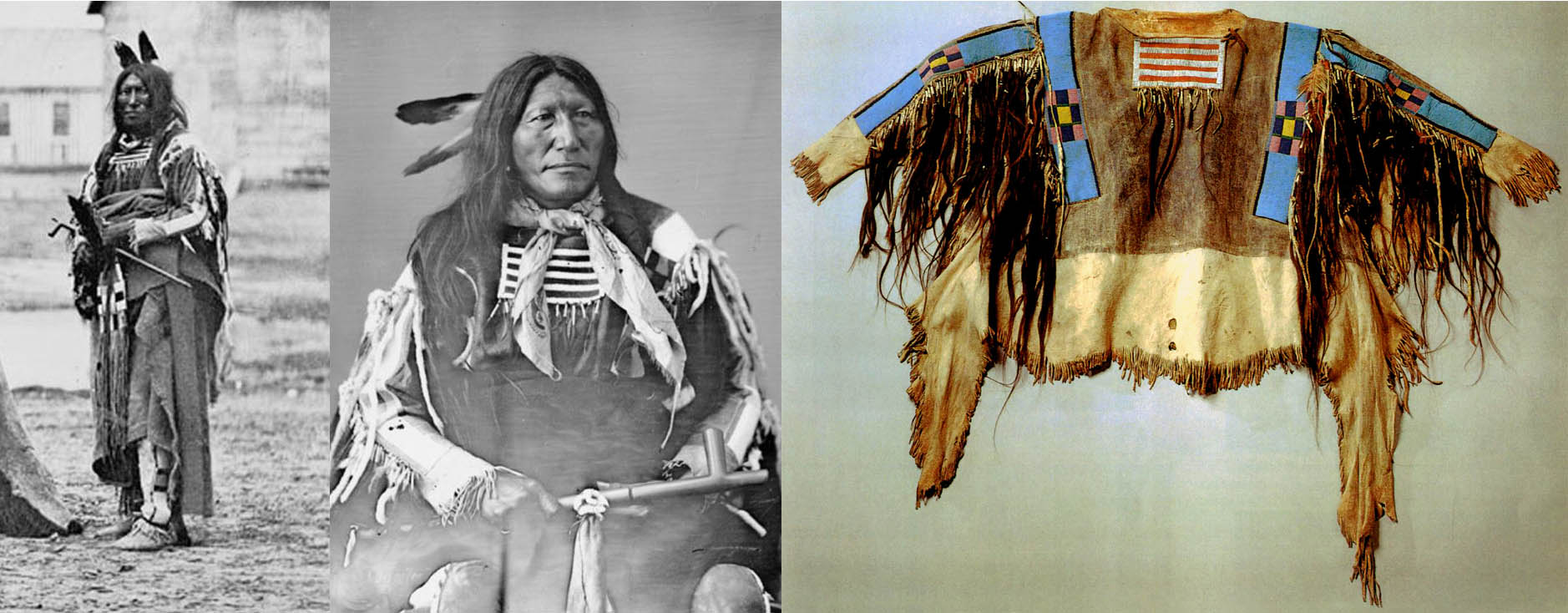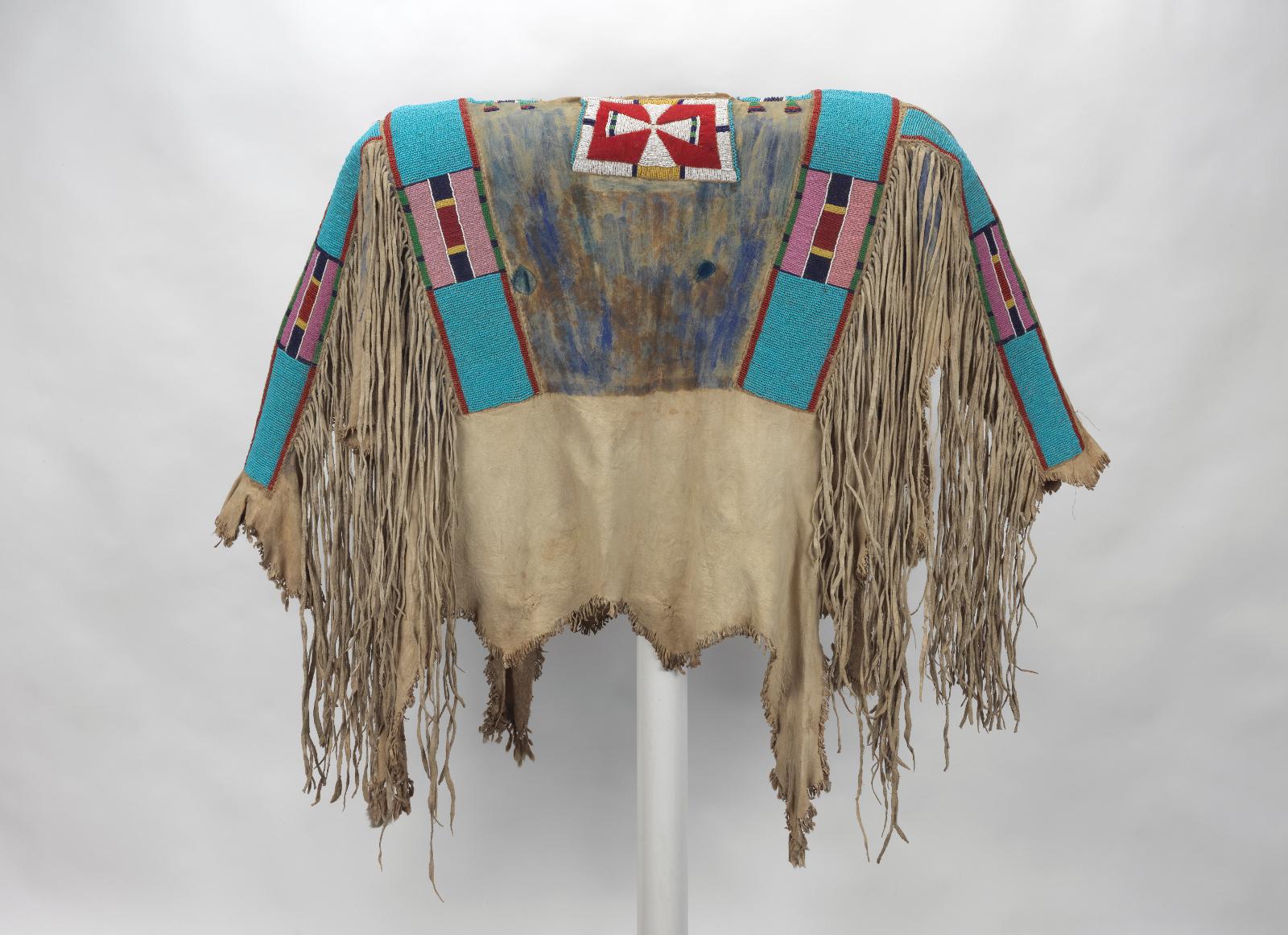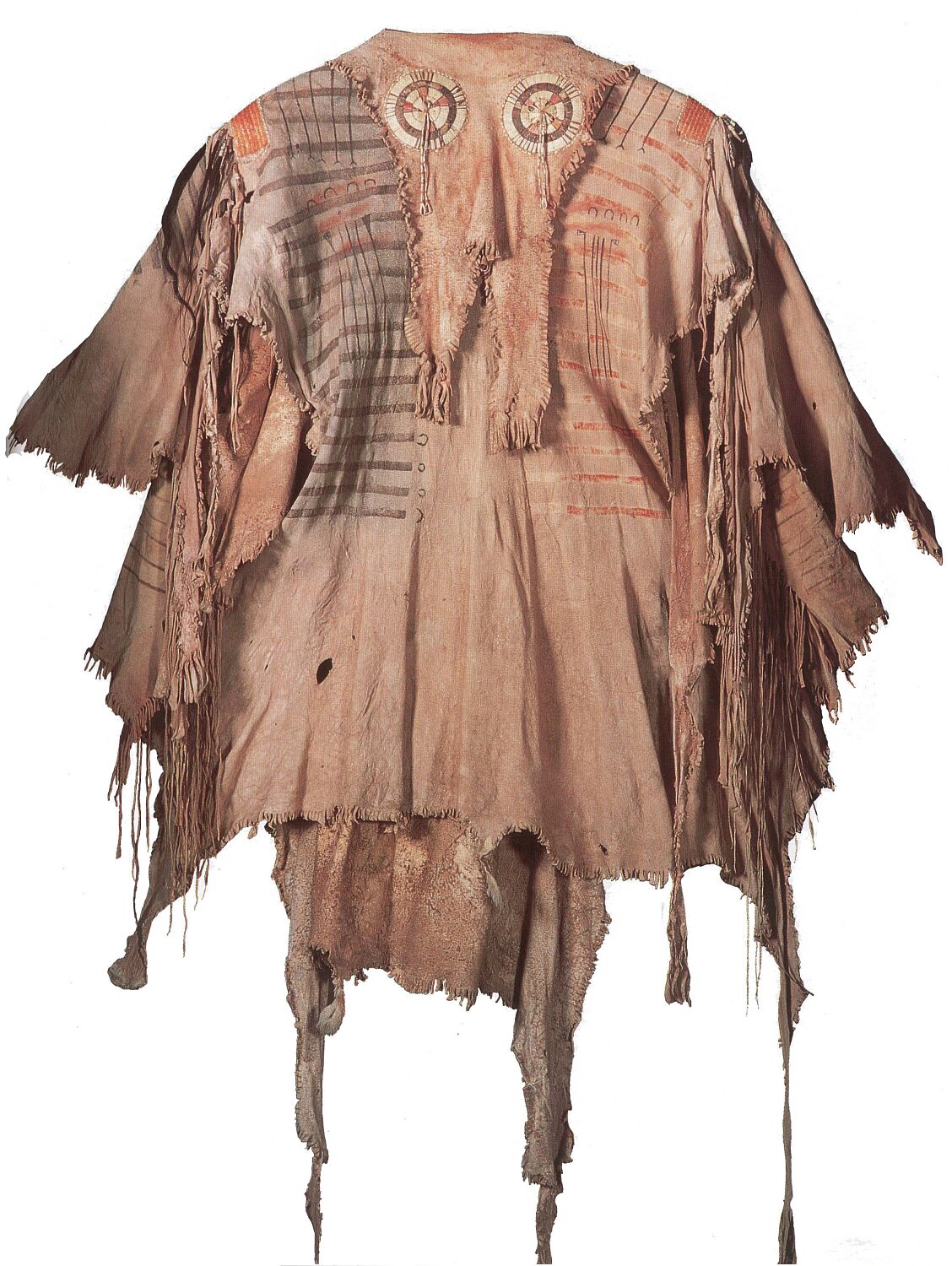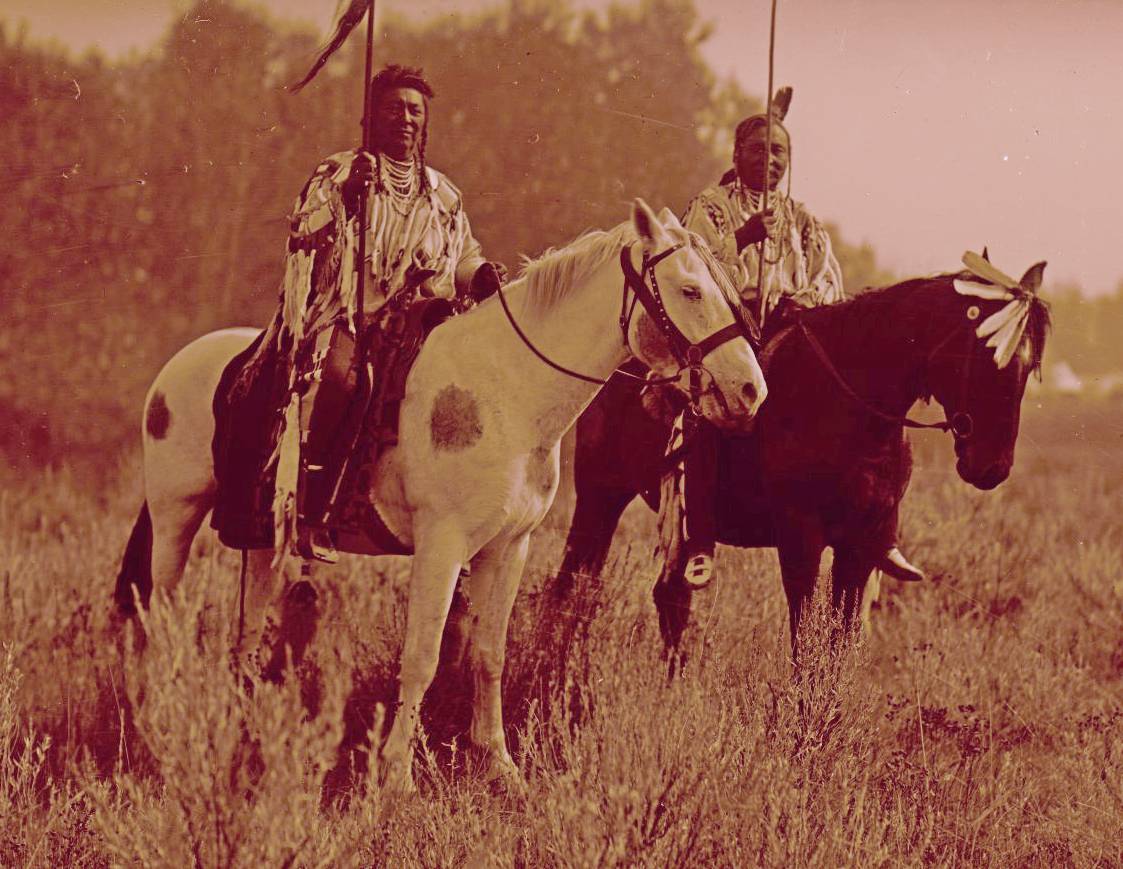War shirts are some of the most beautiful artifacts plains indians produced. They were not just interesting and attractive pieces of outerwear, but rather a sign of social status.
Before earning the right to wear a war shirt, an indian man had to prove himself as an outstanding warrior. Only those men who showed wisdom and strength, repeatedly unprecedented bravery in combat, were known for their selfless character, concern for others and the welfare of the tribe were honoured with the right to wear this kind of shirt.
For example, the Lakota men, who were given such a right were called “the shirt wearers “. If such a “shirt wearer” showed weakness, cowardice or manifested some character flaw, he could be deprived of the right.
A man wearing his war shirt did not simply put on a piece of clothing, but also the insignia of a certain respect, showing his role and social status in the tribe. Period photographs of indian delegations to the white man’s world (mostly in Washington) show the chiefs, who are almost always dressed in war shirts and this indicates their social status within their tribe.

War shirt making
Making a war shirt was considered a sacred activity. Such a shirt was considered to be endowed with spiritual power and strength. This power, or energy, was partly passed onto the shirt during the process of creating it, but most important was the way the members of the tribe perceived it: as a token of a social status associated with certain characteristics of the wearer. This power then passed onto the personwho owned and wore the shirt.

Construction
The shirts were mostly made out of tanned hides, most often white-tailed deer, pronghorn or bighorn sheep. Two to four hides were needed for one shirt, depending on the particular pattern. Both the front and rear part of the shirt always consisted of one hide each, other hides were used for the sleeves.
The front and rear pieces were connected only at the top on the shoulders, hanging loosely down the wearer’s front and back. Originally, the shape of a war shirt respected natural contours of the animal’s hide, and legs often remained intact and were visible on the shirt.
After contacts with Europeans, the plains indians garments started to change its shape somehow, losing its natural animal outlines and becoming more and more “angular”
The four strips
The prominent features of each war shirt were four embroidered strips, decorated with beadwork, quillwork or a combination of both techniques. The beaded or quilled strips were made separately and then stitched onto the finished shirt: the two longer strips decorated the shoulders and the two shorter ones were stitched onto the sleeves.
The beadwork and quillwork was exclusively a women’s job. To make such elaborate embroidery was immensely time consuming, because this was really painstakingly detailed work. Making just several square inches of embroidery took hours, and indian women needed several months to finish these four strips.
The beaded or quilled pieces were sometimes the result of the collective work of several women. Women were particularly proud of their embroidery skills and the most skilled embroiderers were highly respected in the tribe. In some tribes, there existed some special groups of female embroiderers, especially quillworkers (something similar to the craft guilds in Europe) and only members of that group could participate in this craft, which was considered to be a sacred art.
The older and more experienced women supervised the younger members to keep sacred tribal patterns. The patterns were not created arbitrarily, but the patterns were followed very strictly, as there was a belief that those patterns came from higher powers and were the gift of Spirits, containing spiritual power.
Scalp locks, ermine tubes, hide fringes
The shirts were very often embellished with scalp locks, ermine pelts or hide fringes running alongside the four embroidered strips. Decorating with scalps locks was probably the most widely used practice. This is why these wars shirts are sometimes called “scalp shirts”.
The scalps lock were made of thin strands of human hair, wrapped with procupine quills or woolen yarn and fastened to the shirt with a leather thong. Some shirts even bore several hundred of these scalp strands.
Interpretations of the significance of these scalps vary. According to some interpretations these were the scalps of killed enemies, however the Lakota people maintain, they were hair locks from their own tribe members. In cases such as these, wearing the scalp shirts in fact expressed their responsibilities for their own people and tribe.
The use of ermine skin tubes is also interpreted in various ways. According to some sources, a shirt embellished with ermine skins enjoys an even higher status than a “scalp shirt”, while no particular significance was ascribed to leather fringes.
The “Bibs”
In addition to embroidered strips edged with scalps, fringes or ermine pelts, each war shirt was decorated with two so-called “bibs” (triangular, trapezoidal or rectangular areas sewn onto the shirt in the neck area). The use of the word “bibs” to describe them is, of course, derived from the fact that they are in the same place where a small child wears a bib when eating. However, within this context, the reference to “bibs” is purely as decoration, not to food or bibbing. “Bibs” were often decorated with bead or quill embroidery, buckskin fringes, and sometimes human hair or ermine pelts. Usually the two bibs were identical, with one placed in the front and the other in the back. This is due to the Indians’ sense of symmetry.
The “bibs” probably originated naturally, as did many other Indian decorative elements. In fact, deer hides were used for the front and back of the war shirt, whereby the back legs of the hide formed the bottom edge of the shirt, the front the top edge, with the neck of the animal naturally folding down towards the chest, like a natural “bib”. Some very old war shirts (from around 1820) show this natural “bib”, which did not yet have precise contours. It was just a piece of skin from the neck as a result of the skinning and tanning of the hide. Although the earliest bibs were probably undecorated, someone later came up with the idea to decorate them with porcupine quill embroidery. A simple piece of leather therefore became a decorative element.

In the next stage of the bib‘s development as a decorative element, it began to be trimmed and shaped in various ways so as to form various regular geometric shapes, especially trapezoids, rectangles and the like. Fringes were subsequently added, as well as various coloured fabrics and other ornaments. Over time, this simple piece of leather became a work of art, with the women of each tribe developing their own distinctive style.
War shirt painting
Some shirts are endowed with extraordinary power and beauty through painting with earth pigments. The color patterns varied, depending on the tribe, period or place of origin. The Lakota people, for example, often painted their shirts with two colors, yellow and blue or yellow and green. The Crows and other tribes left their shirts undyed or used only a single color, with a shaded effect, where the color was gradually darkened from the bottom towards the upper part. The most often used colors were brown, green and red, with marginally used colours being blue or black.
Pictograms
Some war shirts could be decorated with pictographs and symbols, which depicted the brave war deeds of its owner. For example, each symbol of pipe represented one war party leadership, one horse shoe meant one stolen horse, each figure symbol represented a victim that the war shirt owner killed in combat. Red stains symbolized the wounds sustained in battle and subsequent bleeding. Vertical lines symbolized numbers of counted “coups”.
Pictographic accounts on the war shirt depict battle and combat scenes where its owner took part and showed heroism. Mostly they are scenes of enemies being killed or wounded, counting a coup, yanking a weapon out of an enemy, helping his fellows, horse theft or facing enemy fire.
In battle
In battle it was important for a warrior to wear his war shirt, to show his significance and status in his tribe. Each warrior tried to “count a coup”or kill an enemy wearing a war shirt, because this brought him more fame than overcoming an inexperienced young man without one.
Gift, trade or exchange
In some cases, the shirts could be the subject of a gift (often diplomatic), trophy, exchange or trade. For example, when a warrior was killed with his war shirt on, the winner usually kept it. It is known that sometimes indian delegations exchanged gifts, including war shirts. At other times, a war shirt was even given as a present or sold to a white officer. In intertribal trade, the war shirts could be the subject of trade or exchange.

War shirts today
Nowadays there are quite a lot of preserved original 19th century shirts from the period of the flourishing buffalo culture. Most of them are located in private collections and museums, where we can admire them.
Sometimes, an original war shirt can be offered for sale on the market, but these are usually auctioned items in some prestigious auction houses. The price of such an artifact start at a price of about $100.000and may rise much higher for particularly valuable specimens. A few years ago, a war shirt with documentation that proved it belonged to the famous Nez Perce chief Josef was sold for almost $900.000,- .























